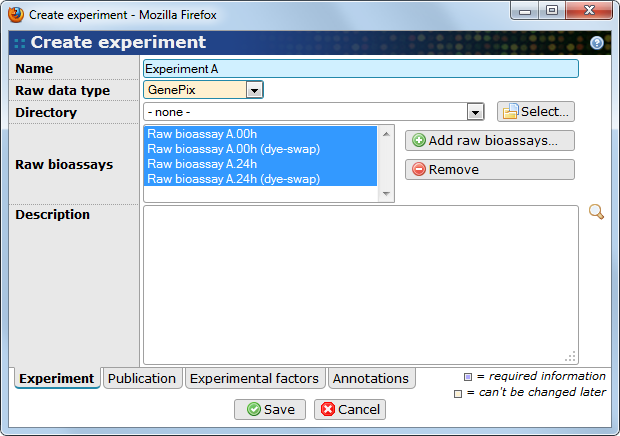Experiments are the starting point for analysis. When you have uploaded and imported your raw data, collected and registered all information and annotations about samples, bioassays, and other items, it is time to collect everything in an experiment.
To create a new experiment you can either mark one ore more raw biossays on the raw bioassays list view and use the button. You can also create a new experiment from the experiments list view.
- Name
-
The name of the experiment.
- Raw data type
-
The raw data type to use in the experiment. All raw bioassays must have raw data with this type.
- Directory
-
A directory in the BASE file system where plug-ins can save files that are generated during the analysis. This is optional and if not given the plug-ins must ask about a directory each time they need it. Use the button to browse the file system or create a new directory.
- Raw bioassays
-
The raw bioassays you want to analyze in this experiment. If you created the experiment from the raw bioassays list the selected raw bioassays are already filled in. Use the button to add more raw bioassays or the button to remove the selected raw bioassays from the list.
- Description
-
A description of the experiment.
Click on the button to save the changes or on to abort.
On this tab you can enter information about a publication that is the result of the experiment. All of this information is optional.
- PubMedId
-
The ID of the publication in the PubMed database.
- Title
-
The title of the publication.
- Publication date
-
The date the article was published. Use the button to select a date from a pop-up window.
- Abstract
-
The article abstract.
- Experiment design
-
An explanation of the experiment design.
- Experiment type
-
A description of the experiment type.
- Affiliations
-
Partners and other related organisations that have helped with the experiment.
- Authors
-
The list of authors of the publication.
- Publication
-
The body text of the publication.
Click on the button to save the changes or on to abort.
The experimental factors of an experiment are the variables you are studying in the experiment. Typically the value of an experimental factor is varied between samples or group of samples. Different treatment methods is an example of an experimental factor.
In the BASE world an experimental factor is the same as an annotation type. Since you probably have lots of annotations on your items that are not relevant for the experiment you must select the annotations types that should make up the experimental factors of the experiment.
Use the button to select the annotation types that should be used as experimental factors. The button removes the selected annotation types.
Click on the button to save the changes or on to abort.
To be able to use the values of the experimental factors in the analysis of your data the values must be accessible from the root raw bioassays. A root raw bioassay is a wrapper around a raw bioassay that is part of the experiment and it has two purposes:
-
Hold experimental factor values for the raw bioassay in the context of the current experiment without affecting other experiments were the same raw bioassay is used.
-
Give the owner of the experiment control over the experimental factor values used. In a multi-project setting this is important since the owner of the raw bioassay may not permit changes to the raw bioassay. Use the clone feature when inheriting annotations to the root raw bioassay to make sure that downstream analysis is not affected by changes made to the original parent annotations (unless you do a manual resync).
Since most of your annotations are probably made at the sample or biosource level the root raw bioassays must inherit or clone those annotations. The experiment view page lists all experimental factors and their current values for each root raw bioassay.
There is a quick access to the batch inherit function that makes it easy to inherit any annotations that are missing. See also Section 10.2.2, “Inheriting annotations from other items” for more information about inheriting annotations.
![[Tip]](../../gfx/admonitions/tip.png) |
Tip |
|---|---|
|
Use the Item overview function to verify that all your raw bioassays has been annotated or inherited values for all experimental factors. If not, you should do that before starting with the analysis. |



